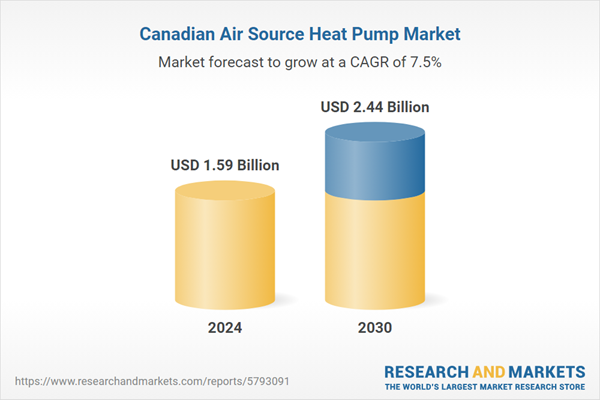Speak directly to the analyst to clarify any post sales queries you may have.
10% Free customizationThis report comes with 10% free customization, enabling you to add data that meets your specific business needs.
Advances in technology have enhanced the performance of heat pumps in cold climates, making them a viable alternative to traditional heating systems. Government incentives and rebate programs further encourage adoption by lowering upfront costs. Increasing awareness among consumers about the long-term cost savings and environmental benefits of air source heat pumps is also fueling market expansion. Additionally, growing electrification trends and commitments to sustainable energy use support the market’s positive outlook in Canada.
Key Market Drivers
Increasing Focus on Energy Efficiency and Environmental Sustainability
One of the strongest drivers of the air source heat pump (ASHP) market in Canada is the rising emphasis on energy efficiency and environmental sustainability. Canada is committed to reducing its carbon footprint and meeting international climate goals, including those set under the Paris Agreement. Traditional heating systems, especially those relying on fossil fuels such as oil and natural gas, contribute significantly to greenhouse gas emissions. ASHPs offer an eco-friendly alternative by utilizing ambient air to provide heating and cooling, consuming far less energy than conventional systems.Canadian consumers and businesses are increasingly aware of the environmental impact of their energy use. This awareness, combined with stricter building codes and regulations promoting energy-efficient construction, is pushing the demand for low-carbon heating and cooling technologies. ASHPs are now being incorporated into new residential and commercial buildings, as well as retrofitted into existing structures, to reduce overall energy consumption and environmental impact.
Key Market Challenges
High Upfront Costs and Installation Complexity
One of the primary challenges limiting the widespread adoption of air source heat pumps (ASHPs) in Canada is the relatively high upfront cost compared to traditional heating systems like furnaces or boilers. Although ASHPs offer significant energy savings and lower operating costs over time, the initial purchase price and installation expenses can be a deterrent for many homeowners and businesses.The installation of ASHPs often requires specialized knowledge and skills, which can increase labor costs. Proper sizing, placement, and integration with existing heating infrastructure are critical to ensuring optimal system performance and efficiency. Additionally, in some cases, retrofitting older buildings with ASHP technology involves modifying ductwork, electrical systems, or insulation, which adds to the overall expense and complexity.
Key Market Trends
Integration with Smart Home and Building Automation Systems
A significant trend in the Canadian air source heat pump (ASHP) market is the increasing integration of heat pumps with smart home and building automation technologies. Modern consumers and commercial building managers seek enhanced control over their heating and cooling systems to optimize comfort, energy savings, and operational efficiency. Manufacturers are incorporating IoT (Internet of Things) capabilities into ASHPs, enabling remote monitoring and control via smartphones or home assistants. Users can schedule temperature settings, monitor system performance, and receive maintenance alerts, all through intuitive apps. This connectivity allows for smarter energy management, including demand response features where the system adjusts operation based on electricity grid conditions or time-of-use rates.In commercial and multi-residential buildings, ASHPs are being integrated into broader building management systems (BMS), allowing centralized control of HVAC, lighting, and other utilities. This holistic approach helps reduce energy consumption, improve occupant comfort, and facilitate compliance with green building certifications. As digitalization grows across sectors, smart integration is set to become a standard feature, driving market growth and enhancing user experience.
Key Market Players
- GREE Electric Appliances Inc.
- Senvilla.Ca
- Mitsubishi Electric Sales Canada Inc
- Trane Technologies Company, LLC
- Wolf Steel Ltd.
- Hometown Heating Inc.
- Johnson Controls
- Panasonic Canada Inc
- Rheem Manufacturing Company
- Mr Cool Canada
Report Scope:
In this report, the Canada Air Source Heat Pump Market has been segmented into the following categories, in addition to the industry trends which have also been detailed below:Canada Air Source Heat Pump Market, By Process:
- Air to Air
- Air to Water
Canada Air Source Heat Pump Market, By End Use:
- Residential
- Hotels & Resorts
- Gym & Spas
- Education
- Food Service
- Others
Canada Air Source Heat Pump Market, By Sales Channel:
- Plumbers
- Dealers & Contractors
- Retail
- Direct Sales
- Online
- Others
Canada Air Source Heat Pump Market, By Region:
- Quebec
- Ontario
- Alberta
- British Columbia
- Saskatchewan & Manitoba
- Rest of Canada
Competitive Landscape
Company Profiles: Detailed analysis of the major companies present in the Canada Air Source Heat Pump Market.Available Customizations:
With the given market data, the publisher offers customizations according to a company's specific needs. The following customization options are available for the report.Company Information
- Detailed analysis and profiling of additional market players (up to five).
This product will be delivered within 1-3 business days.
Table of Contents
Companies Mentioned
- GREE Electric Appliances Inc.
- Senvilla.Ca
- Mitsubishi Electric Sales Canada Inc
- Trane Technologies Company, LLC
- Wolf Steel Ltd.
- Hometown Heating Inc.
- Johnson Controls
- Panasonic Canada Inc
- Rheem Manufacturing Company
- Mr Cool Canada
Table Information
| Report Attribute | Details |
|---|---|
| No. of Pages | 81 |
| Published | September 2025 |
| Forecast Period | 2024 - 2030 |
| Estimated Market Value ( USD | $ 1.59 Billion |
| Forecasted Market Value ( USD | $ 2.44 Billion |
| Compound Annual Growth Rate | 7.4% |
| Regions Covered | Canada |
| No. of Companies Mentioned | 10 |









